Having fun with your team creates fun on the air. But personality radio should always be centered around the audience, says radio consultant John Simons.
At Next Radio 2013, the former Group PD of Real and Smooth presented his Breakfast Show Health Check – 10 ways to tell if your morning show is the real deal. He believes in personality radio and real-life storytelling that first and foremost relates to the audience. “Make sure it’s not too me, me, me; make sure it’s more you, you, you.”
“Really useful if you’ve got a
dysfunctional breakfast show”

Clashing egos within a morning show team, such as Hirsty’s Daily Dose on Capital FM Yorkshire, makes it necessary to agree on unbreakable rules for on-air behavior, to help structure the show (photo: Facebook / simonhirsty)
1. Have before & after meetings
– Do they arrive 45 minutes prior to the show starting, and have a post-show meeting every day?
“Both of those things are absolutely essential”, says John Simons (John Potts), formerly Group Program Director for GMG Radio. He left mid 2013, after Global Radio bought the company, to become a consultant. Having been a deejay himself once as well, he knows that most jocks turn up five minutes before the show or even during the news, while it’s crucial to be in the studio on time for a pre-show meeting and to do (additional) showprep. There should also be an after-show meeting to evaluate today’s morning show and then plan the next one. “If they aren’t doing it, they’re not doing the best that they can do.”
 2. Make long-term production plans
2. Make long-term production plans
– Do they have one major planning session every two weeks?
The consultant points out that – instead of getting “stuck on the treadmill of working for tomorrow’s show” – it’s key to look ahead. Morning shows should keep a calendar of regular anniversaries and other pre-scheduled events, and anticipate before these events actually take place [see also: Dave Foxx Z100: Big Picture = Better Production].
3. Define radio personality traits
– Do they have a set of team rules?
“This is useful if you’ve got a dysfunctional breakfast show.” Simons knows that when team members have strong egos or complex characters, their personalities probably collide (as Simon Hirst says in: Successful Morning Shows Are Like Real-Life Soaps). Teams of high-profiled people should therefore “sit down and define the rules that they all agree to – and stick to the rules”. One of the important things is to characterize each individual on the show, so listeners can keep them apart. “Do a lot of work on that with the talent and make sure they define their personalities.”
“That’s not lying;
that’s called production”
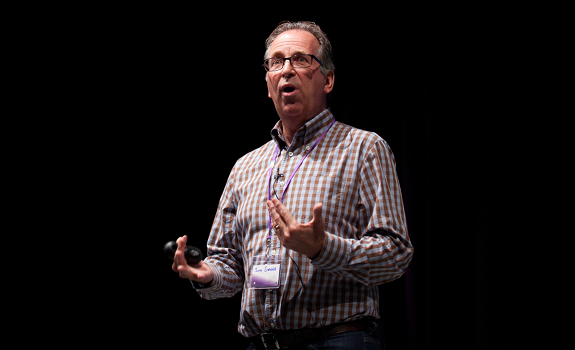
Radio consultant John Simons advocates ‘creative production’, like occasionally using existing stories as inspiration for stories that could have happened – but did not really happen – in a presenter’s personal life (photo: Next Radio)
4. Map out shows before
– Do they complete a planning sheet for the next show?
While almost every morning show does have a planning sheet, John Simons is asking: “How many times do they just fill it in, so they can leave it on the program director’s desk and they don’t actually take heed to what’s on that piece of paper? If you want to know where you’re going, you need a map. If you’ve got it, you can straight off the route and come back to the end point. If you don’t have a map, you’re buggered.”
 5. Screen & produce phone-ins well
5. Screen & produce phone-ins well
– Do they get well-prepped listeners on the air every day?
Instead of saying: how are you today?, a presenter should ask something significant related to what a producer found out about the caller during the screening call. Cutting out unnecessary preamble is not only saving airtime: “It makes the listeners think as though you really care”, he explains. “Therefore they warm to you, and you get more out of them.”
6. Include personal real-life stories
– Do they prepare at least two stories about their own lives every day?
Hard-working morning show teams are often at the radio station and get to sleep early. Still, there are certain times of the day and week when they do have a normal life. The advice is to “write things down and build up a back log of stories. These are always the best ones.” Simons suggests that when presenters don’t have a real-life experience at hand, they could find inspiration from a story on the news or on the Internet, and personalize it. “That’s not lying; that’s called production.”
“You’ve got to hook and tease content,
and it’s got to be laser-pinpointed”
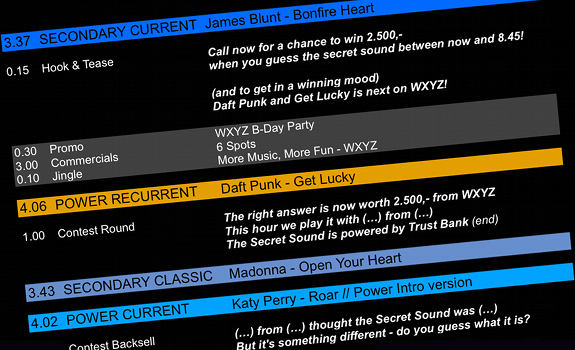
Pre-selling content – rather than (only) music – 20 minutes ahead makes people listen longer (image: Thomas Giger)
7. Find & develop unique characteristics
– Does the show become famous for something?
John Simons believes that morning shows should be more than funny and topical. “What is your show becoming renowned for in the market?” He explains that successful benchmarks can be anything from prank calls and standard contests like The Ten Grand Vend to charity events and listener rescues. For example, the station might support a family with a young child that needs to go to America for a life-saving operation. “You can build a reputation for helping people. That can be one of your real key assets.”
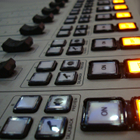 8. Avoid cutting off songs
8. Avoid cutting off songs
– Do they respect the music?
Even if most shows are using short morning show edits, it happens that “you hear a presenter take a chainsaw and hack it in two”. Cutting off or talking over songs is something that listeners obviously do not appreciate. “It’s about thinking ahead.” (If you do proper back timing, you should always be able to play the complete song before going into news or commercials).
9. Tease upcoming content regularly
– Do they do a planned hook & tease into every ad break?
Simons makes clear why simply pre-selling music just doesn’t cut it anymore. “Pretty much everyone’s playing the same songs anyway. You’ve got to hook & tease content – about 20 minutes ahead, and it’s got to be laser-pinpointed. At ten to eight this morning, we’re going to talk about X, Y and Z – that’s twenty minutes from now, at ten to eight.” He thinks that there should be a tease like this at least 2 or 3 times every hour. That’s why it’s so important to have a completed prep sheet, which maps out all stories and topics.
“It should be ‘devil may care’;
it should be you against the suits”
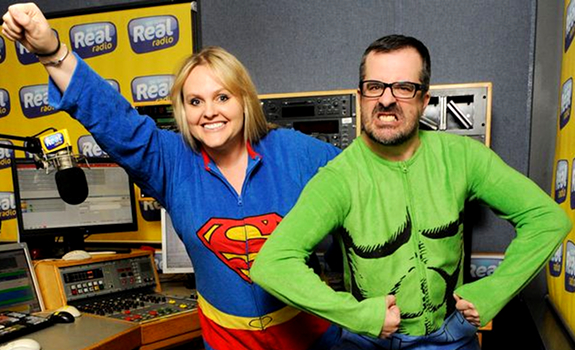
Successful morning shows, such as Real Radio Breakfast with Ewen Cameron (right) and Cat Harvey (left), find balance between preparation & structure on one side, vs. spontaneity & attitude on the other (photo: Real Radio)
10. Run several ongoing stories
– Do they bring a sense of soap opera to the show?
“This is really difficult, but this is what the most successful breakfast shows drive their success through”, John Simons knows. “It’s making sure that if someone misses a show, it wretches with then and they think: oh, my goodness, I missed that show. I wondered what has happened this morning.” The key is to create both short- and long-term storylines: “There needs to be character-led stuff in the show about presenters that makes [listeners] come back every day and want to know what’s going to happen in today’s episode.”
 Produce more than enough
Produce more than enough
Showprep is more than just plain-old paperclipping. “It’s gathering material from your imagination; your community; your family; your life. Everything you do, can be a topic on the show.” An important tip is to gather more material than you need: “I used to go into the studio with at least ten things, and then I used two. If I had ten things on the list, I felt comfortable and safe.”
Use music sweeps effectively
Simons advises to practice the next talk while the music plays. “Talk it through with your co-host or producer. Make sure you know what the beginning, middle and end is.” During rehearsal, content should be condensed to its essentials. “Get it down to significant sentences and bullet points, but make it sound natural as well.” About the on-air performance, he reminds that above all “radio is fun! It should be stupid; it should be daft; it should be ‘devil may care’; it should be you against the suits; it should be about having some craziness in the studio. If you’re having fun, funny things will happen.”
“Winning shows are a series of one”
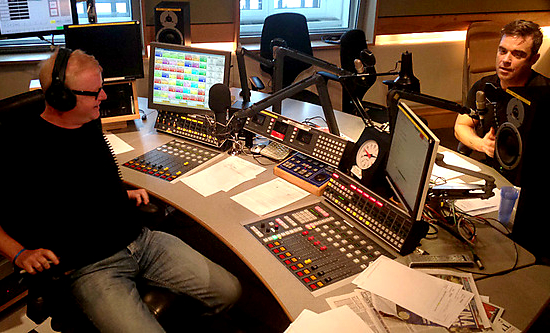
Chris Evans, here interviewing Robbie Williams on BBC Radio 2, has successfully built his day-to-day success into a long-lasting career as a radio personality and media entertainer (photo: BBC)
Present service elements consciously
Radio personalities are often more engaged with their self-produced content than with other morning show format elements. “How many times presenters don’t listen to the news? I used to make presenters drive the news bulletins, because then they had to listen to the news”, John Simons recalls. “The weather and travel; how often is that thrown away? The guy reads the weather out; 30 seconds later he doesn’t have a clue what he said.” In his opinion, talents should always (make themselves) care about service elements. “If you’re bored with them, sure as hell your listeners are bored as well.”
 Talk about pop culture
Talk about pop culture
He reminds music-driven format jocks that “selling the music is still one of the most important things” and has a good idea for presenters who work in a more conservative environment with less current and more classic songs. “If you’re on an AC station and there’s a hot new song by Katy Perry that you can’t play, you can still talk about it – because [she] is a big personality. It lets you keep in touch with the total audience.”
Become top of mind
Simons states that “winning shows are a series of one”, and that you can develop your show on both the short and long term by doing:
- one thing per quarter hour that commands attention:
- one item per hour that causes a response
- one bit per day that is sharable
- one thing per quarter that listeners remember
- one event per year that makes you legendary
“The key to star quality is:
entertain me, or talk about me”
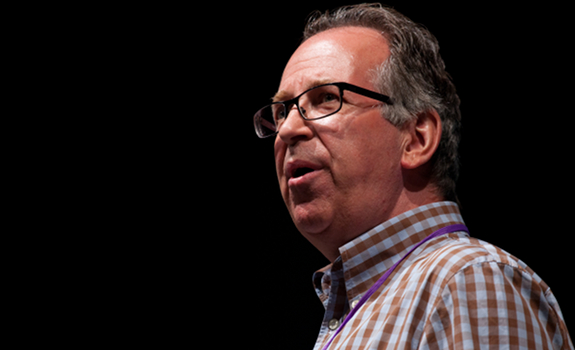
John Simons underlines that radio is about the listener – not (just) about the people who make it (photo: Next Radio)
Employ talented & senior producers
Behind every successful morning show stands a great producer. He or she should have a bigger vision of the show, and should be able to stand back and relate to what the presenters are going through. John Simons explains the mediator role of a producer: “The program director can use them as a conduit, instead of going directly to the talent. But also, the producer can represent the talent with the program director.” He feels like there are too many young breakfast show producers, while they should have a certain level of experience and maturity to be respected by both the talent and the PD.
 Picture your target listener
Picture your target listener
As a radio programmer he learned that it’s crucial to know details about your audience. If the target listener is a young female – which is the case for many commercial stations – the morning show team members should (literally) have her picture in front of them. Is this model listener single, or a single mother? Does she have a job – and is it only one, or does she have two or three part-time jobs?
Set your ego aside
Simons knows that “if you work in radio, you’ve got to have an ego” – but also that in the end, it’s not about the people in the studio. “It’s about media-savvy listeners who count on you and your show every day to get something that they need. So make sure that you’re respectful when you deliver that.” While the station is a brand, “personalities can still sit comfortably in that brand, as long as they understand the station’s brand values. The key to star quality is: entertain me, or talk about me. When you’re telling a story, make sure it’s not too me, me, me; make sure it’s more you, you, you. Relate it to your listener.”





Fan-tas-tic … This is pure Morning Show DNA. Thank you, John.